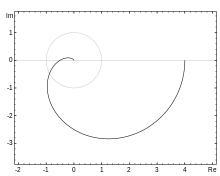奈奎斯特图

奈奎斯特图(英語:Nyquist plot)是對於一個連續時間的線性非時變系統,將其頻率響應的增益及相位以極座標的方式在复平面中繪出,常在控制系統或信號處理中使用,可以用來判斷一個有反馈的系統是否穩定。奈奎斯特图的命名是來自貝爾實驗室的電子工程師哈里·奈奎斯特(Harry Nyquist)。
奈奎斯特图上每一點都是對應一特定頻率下的頻率響應,該點相對於原點的角度表示相位,而和原點之間的距離表示增益,因此奈奎斯特图將振幅及相位的波德圖綜合在一張圖中。
一般的系統有低通濾波器的特性,高頻時的頻率響應會衰減,增益降低,因此在奈奎斯特图中會出現在較靠近原點的區域。
用途
[编辑]閉環负反馈系統的穩定性評估可以由开环系統(同一個系統,但不考慮其反馈迴路)的奈奎斯特图,配合奈奎斯特稳定判据判斷其穩定性。此方法甚至可以用在有延遲的系統,或是传递函数不是有理函數的系統,這些系統用其他方法都很難分析。可以藉由图线围绕的次數及開環传递函数右半平面的極點数量來判斷穩定性。增益裕度可以用圖形越過實軸的數值(幅值裕度),或图线穿过单位圆时的相位(相角裕度)來計算。
奈奎斯特图可以提供一些有關传递函数的信息。例如曲線進入原點時的角度可以計算極點個數和零點個數的差[1]。
當手繪奈奎斯特图時,可以畫出圖形的外觀,但座標軸部份有些調整,以顯示一些重要部份的信息。當用计算机绘图時,需要包括所有有關的頻率範圍,因此頻率可能會用對數的方式增加,以包括大的頻率範圍。
相關條目
[编辑]参考文献
[编辑]- ^ Nyquist Plots. [2013-09-14]. (原始内容存档于2008-09-30).
外部連結
[编辑]- Applets with modifiable parameters(页面存档备份,存于互联网档案馆)
- EIS Spectrum Analyser - a freeware program for analysis and simulation of impedance spectra(页面存档备份,存于互联网档案馆)
| ||||||||||||||||||||||||||||||||
Text is available under the CC BY-SA 4.0 license; additional terms may apply.
Images, videos and audio are available under their respective licenses.

